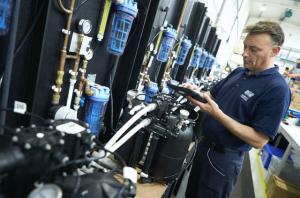Debbie Boxall, Harvey Water Softeners
Limescale: the hard, off-white deposit of calcium carbonate that’s left behind by hard water when it evaporates. It’s responsible for unsightly bathrooms, ineffective heating systems and frequent tradesperson maintenance call outs!
Build-ups of limescale which form on the inside of heating pipes insulate the hot water flowing through and prevent it from heating a property efficiently; while limescale that builds up in kettles, on taps and showerheads not only looks unattractive, but reduces the performance of these appliances over time.
When you finish an install, you hope that your customers will be satisfied with their new boiler or appliance for years to come, however if they’re based in a (hard water area) this is unlikely to be the case. If you’re receiving maintenance calls just a couple of years after you installed a boiler you may think, ‘Great, another call out’. More likely though, you might bemoan how these smaller jobs eat up the time that could be spent on bigger, more lucrative ones. Maximum customer satisfaction and reducing unnecessary maintenance costs will also be priorities.
Your customers can cut their risk of limescale by installing a water softener: a device that’s fitted under the kitchen sink to remove the harsh minerals of calcium and magnesium from the mains water supply. This prevents future build-ups of limescale, will break down existing limescale build ups and will also reduce the soap residue left around the home.
As a busy tradesperson, you’ll want to service your customers as quickly as possible and for the best margins - you can do without obstacles like hard water getting in the way. Installing a water softener will prolong the lifespan of your plumbing work, the appliances you install - including boilers - and reduce unnecessary maintenance; it’s one investment that protects all other plumbing investments.
Water softening
Water softeners operate on a process of ion-exchange. The property’s mains water supply enters the water softener and moves through an ion-exchange resin bed of tiny, synthetic beads, which have been specially formulated and charged with sodium ions.
This is where the exchange happens: calcium and magnesium ions in the hard water are replaced by the sodium ions and this process continues until all the sodium in the resin bed has been used up. The water that flows out of the water softener is then soft.
The regeneration process
Once it has softened a certain volume of hard water, a water softener needs to regenerate. Most water softeners regenerate automatically after a preset amount of water has passed through; this volume will vary according to how hard the water is. The harder the water, the faster the salt gets used - this hardwater postcode checker gives you a good indication. On average, one salt block will be used per household member each month.
During the regeneration process the resin bed is rinsed of the harsh mineral ions and recharged with sodium ions by being flushed through for 10 minutes with a brine solution.
Single tank vs twin tank
There are a number of different water softeners on the market, however only twin tank water softeners work continuously to protect a property from limescale 24 hours a day, seven days a week. Like it sounds, single tank water softeners have one cylinder and so are usually cheaper; however they’re also less effective, because they can’t soften water at the same time as regenerating.
Twin tank water softeners have, you guessed it, two cylinders - meaning that while one tank is being flushed with brine solution the other keeps on softening. Because it works throughout the day and night, homeowners get longer lasting appliances, pipes and boilers.
Installation and maintenance
To be most effective, water softeners need to be plumbed in close to where the mains water supply enters the property, usually under the kitchen sink. Installation is usually hassle-free - a little more work than installing a washing machine but a lot easier than a boiler; the process takes about three hours. Twin tank softeners shouldn’t need any further maintenance after that, other than the addition of new salt blocks as and when needed - and the homeowner can easily add that.
A water softener helps to keep your customers satisfied with your services for longer and protects their expensive appliances from limescale damage. For hard water homes, it’s a wise investment.

Add new comment